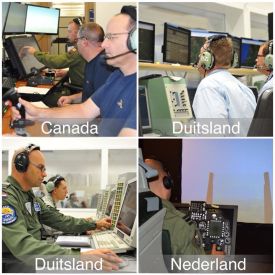 An international simulation training was recently held at Volkel Air Base, in which two of the NLR’s F-16 simulators were deployed. These simulators are part of the NLR’s Fighter 4-Ship research facility.
An international simulation training was recently held at Volkel Air Base, in which two of the NLR’s F-16 simulators were deployed. These simulators are part of the NLR’s Fighter 4-Ship research facility.
During this NATO exercise, the Dutch F-16 simulators were linked to the Canadian F-18 simulators in Trenton, and the German Eurofighter simulator in Manching. Additionally, a link was made with the German Simulation Control Centre in Cologne, and the NATO AWACS in Geilenkirchen.
The training was based on the principle of ‘Mission Training through Distributed Simulation’ (MTDS): training with others at large distances via simulation.
The Netherlands participates in these types of trainings with the NLR’s Fighter 4-Ship. The Fighter 4-Ship is a research simulator in which collective and tactical operations are simulated. Air Force Command (CLSK) rents the Fighter 4-Ship, because their current simulation tools are not suitable for this type of exercise. The new generation, which will be commissioned in 2016, will be suitable.
The training was conducted under the auspices of the NATO working group MSG-128. On behalf of the Netherlands, the ATTS department participates in this working group and supports the Ministry of Defence in the (technical and operational) set up of a permanent MTDS architecture, for which ATTS has defined the data, interfaces, tools and network architecture. Moreover, ATTS, in collaboration with Air Force Command (CLSK) and the international partners, has devised the concept for the MTDS-training (the scenario, test plan and recommendations).
The NATO working group is working on a permanent MTDS network infrastructure, in which the various simulators (joint and combined) can be linked to each other, so that with a short ‘lead-time’ a simulated training can be easily set up as a ‘real-life’ training. The training will be held again next year, when more countries will join in order to create an increasingly larger permanent network.
Within the Air Force Command (CLSK), this training is a good step toward creating a national simulation infrastructure. The new ULTs that will be delivered by the end of this year, or the beginning of next year, to the Volkel and Leeuwarden Air Base will not be linked initially. For Air Force Command (CLSK), the lessons learned from the current training will serve as a step toward linking the new ULTs with each other. It is highly probable that Air Force Command will once again rely on the expertise in networked simulations that ATTS has developed over the past 15 years.
Air Force Command (CLSK) has drafted its Master Plan CLSK 3.0: “By 2019, 25% of all trainings will be conducted in simulators. By 2024, 50% of all trainings will be conducted in simulators.” This objective establishes a clear precedent: simulations will become increasingly important in the coming years. Consequently, this training plays an important role in this endeavour.

